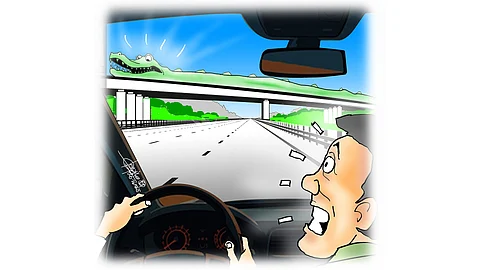
- NEWS
- the EDIT
- COMMENTARY
- BUSINESS
- LIFE
- SHOW
- ACTION
- GLOBAL GOALS
- SNAPS
- DYARYO TIRADA
- MORE

Heralded as a solution to Metro Manila’s crippling traffic, the elevated Skyway toll road has instead turned into a model of corporate greed and exploitation which has elicited views as an anti-people infrastructure that prioritizes profit over the public welfare.
The toll fee it charges can be compared to a regressive tax disguised as a user fee. When Stage 3 introduced tolls in July 2021, after a brief free period, commuters faced burdensome rates.
For a simple driver who wants to use the tollway to get around Manila’s notorious traffic jams, the fees aren’t just an inconvenience but a financial chokehold, especially given the system’s unfinished state.
The flagship project is riddled with missing ramps and unresolved bottlenecks that translate to premium prices for a half-baked service, a classic bait-and-switch similar to a politician who makes grand promises during the campaign but, once elected, pursues an entirely different agenda.
A financial analyst estimates that the project is near breakeven, reckoning operating costs this year of about P12 billion to P15 billion against revenues of 13 billion to P15.5 billion.
From a heavily subsidized operation, the Skyway has moved to one where toll revenues are catching up, though not yet comfortably covering costs across all stages.
A prospect for SMC will be to still raise the toll rates to secure a surplus, according to the analyst.
Secretary Vince Dizon’s first move as head of the Department of Transportation was to shelve the cashless toll system which appeared to have been imposed by the tollway operator on the Toll Regulatory Board.
Dizon called the measure anti-poor as it discriminates against those who cannot afford to consistently top up their radio-frequency identification (RFID) tags, like cab drivers.
The RFID system has become a particular pain point for motorists.
A frequent complaint is the inconsistency in reading the RFID tags. Many toll gate sensors fail to detect the Autosweep stickers, even when they are properly installed and funded.
This leads to an inconvenience as toll booth staff have to manually intervene, and ridiculously wave the reader near the tag or ask the driver to reposition his vehicle.
These incidents involving the RFID tags cause delays defeating the purpose for which the Skyway was built.
A frequent sore point is the traffic caused by drivers with low or zero RFID balances where drivers are forced to reload on the spot or face barriers not lifting, frustrating those behind them.
The system lacks detectors to flag low balances before entry, particularly since most of the time the top-ups don’t appear immediately despite having been loaded in advance.
Lodging complaints and disputing erroneous charges are cumbersome and SMC’s response is usually slow, reflecting its indifference.
The process to contest a transaction requires tickets that have layers of requirements that those who feel cheated only get frustrated and let it go.
For paying a premium, compared to the rival elevated road system operated by another business group, users of the Skyway expect the operator to fulfill its promise of “highest standards of safety, speed, and convenience.”
The Skyway should not only deliver on its promises but it should be flawless in its operations.
Unless operations are stepped up it would enforce the view that the collection system is “extortionary.”
When the Skyway was inaugurated, offering free passage for a short period, motorists felt that modern travel had finally arrived.
Now, many believe they expected too much too soon.
